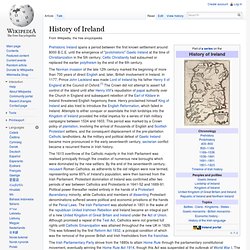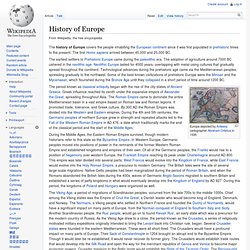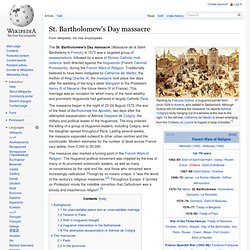

History of Ireland. Prehistoric Ireland spans a period between the first known settlement around 8000 B.C.E. until the emergence of "protohistoric" Gaelic Ireland at the time of Christianization in the 5th century; Celtic Christianity had subsumed or replaced the earlier polytheism by the end of the 6th century.

The Norman invasion of the late 12th century marked the beginning of more than 700 years of direct English and, later, British involvement in Ireland. In 1177, Prince John Lackland was made Lord of Ireland by his father Henry II of England at the Council of Oxford.[1] The Crown did not attempt to assert full control of the island until after Henry VIII's repudiation of papal authority over the Church in England and subsequent rebellion of the Earl of Kildare in Ireland threatened English hegemony there.
Henry proclaimed himself King of Ireland and also tried to introduce the English Reformation, which failed in Ireland. Prehistory (8000 BC–400 AD)[edit] The Iron Age in Ireland began about 600 BC. British Isles. History of Europe. The history of Europe covers the people inhabiting the European continent since it was first populated in prehistoric times to the present.

The first Homo sapiens arrived between 45,000 and 25,000 BC. The earliest settlers to Prehistoric Europe came during the paleolithic era. The adoption of agriculture around 7000 BC ushered in the neolithic age. Neolithic Europe lasted for 4000 years, overlapping with metal-using cultures that gradually spread throughout the continent. Technological advances during the prehistoric age came via the Mediterranean peoples, spreading gradually to the northwest.
The period known as classical antiquity began with the rise of the city-states of Ancient Greece. Eastern Europe in the High Middle Ages was dominated by the rise, and later fall, of the Mongol Empire. The period between 1815 and 1871 saw a large number of revolutionary attempts and independence wars. Following the Allied victory in the Second World War, Europe was divided by the Iron Curtain. Scotland. The Histomap by John Sparks, 1931, depicts the ebb. Coursekit is now Lore.

What’s the Story? Art & Design Culture & Society History & Literature The Histomap by John Sparks, 1931, depicts the ebb and flow of world powers from antiquity to today, part of a visual history of the timeline . #maps #politics #history #infographics 906 notes justdanceandlaugh reblogged this from wnycradiolab and added: OMG look at this!!!! Dailydeaths liked this andwehavearrived reblogged this from ilovecharts mycorrhizae reblogged this from mcad-publicationdesign etscientia liked this homecomingqueen reblogged this from ilovecharts citysurvivor reblogged this from lisbonworldnews renaissance-inspirations reblogged this from 2-little-whos 2-little-whos reblogged this from explore-blog lisbonworldnews reblogged this from ilovecharts limitedtortlawyer reblogged this from theatlantic cadernografico liked this moistbeverage reblogged this from explore-blog achat-d-or reblogged this from explore-blog slimikins reblogged this from explore-blog rosalafae liked this r0ki liked this.
St. Bartholomew's Day massacre. The St.

Bartholomew's Day massacre (Massacre de la Saint-Barthélemy in French) in 1572 was a targeted group of assassinations, followed by a wave of Roman Catholic mob violence, both directed against the Huguenots (French Calvinist Protestants), during the French Wars of Religion. Traditionally believed to have been instigated by Catherine de' Medici, the mother of King Charles IX, the massacre took place five days after the wedding of the king's sister Margaret to the Protestant Henry III of Navarre (the future Henry IV of France).
This marriage was an occasion for which many of the most wealthy and prominent Huguenots had gathered in largely Catholic Paris. The massacre began in the night of 23-24 August 1572 (the eve of the feast of Bartholomew the Apostle), two days after the attempted assassination of Admiral Gaspard de Coligny, the military and political leader of the Huguenots. The massacre also marked a turning point in the French Wars of Religion. Background[edit] Paris[edit]